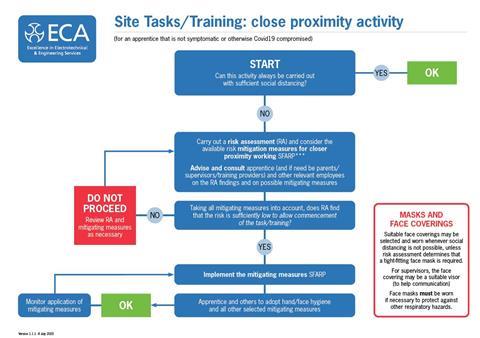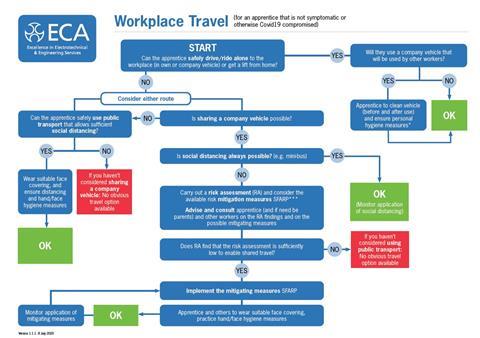ECA’s director of CSR, Paul Reeve, explores the possibilities for apprentices – and others – to travel and work safely on site in these continually challenging times …

Carrying out essential work and even travel in close proximity has presented new operational problems across construction and RMI. Apprentice travel and training has been flagged up as a particular challenge, with some companies pondering how to get those apprentices who do not drive to, from and around sites. Others have questioned whether it’s possible to carry out close-proximity apprentice training and supervision.
Apprentices are vital to current and future operations in our sector, so ECA has produced two flow charts that clearly show various practical solutions to these issues.
By now we all know the three most effective routes to preventing the spread of coronavirus on site and when travelling:
• Social distancing
• Effective hand washing
• Thorough sanitising/cleaning of all contactable surfaces and equipment – plus preventing unnecessary sharing of items or equipment.
While all activities should be planned and organised to avoid unnecessary close proximity (work less than 2m apart) sometimes close proximity, such as supervising apprentices’ work, or travelling in shared vehicles, is necessary.
If close-proximity apprentice activity needs to continue for the business to operate – which may include essential training, supervision and various tasks – the first thing to do is conduct a suitable and sufficient risk assessment.

That risk assessment should include all the necessary mitigating actions (applying a range of preventive measures) to eliminate or control the risk of transmission from close proximity work. This means implementing as many of the following as reasonably practicable:
- Minimise the number of workers operating or driving within 2m of each other
- Minimise the frequency and time workers are within 2m of each other.
Keep those involved in closer proximity:
• Together (avoid swapping workers within work pairs or teams)
• Away from other workers, where possible.
Workers should work side by side or facing away from each other: avoid face-to-face working wherever possible and consider using temporary barriers between workers (for instance, clear flexible barriers in vehicles, notably for essential longer journeys).

Also consider:
- Using an authorisation process for close proximity activities
- Providing designated supervision (such as a “compliance champion”) to monitor and manage compliance with your preventative measures.
Face coverings?
Finally, face coverings or visors can additionally be used, but do not rely solely on these as the sole mitigating measure. The measures above must first be deployed, to mitigate the risk as far as reasonably practicable. For more information on this subject, please also see the ECA/BESA GN2 “close proximity” guide at: .
Download the flow charts on the link below.
These flow charts (which can be adapted to any workers at close proximity) aim to help employers understand their options and make well informed health and safety and employment decisions about the continued deployment of apprentices on-site.
Downloads
Travel flowchart
PDF, Size 46.88 kbSite flowchart
PDF, Size 43.81 kb


























